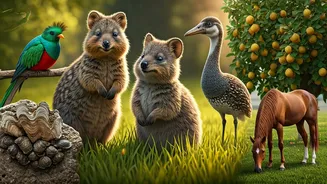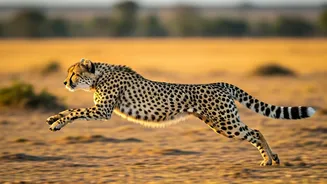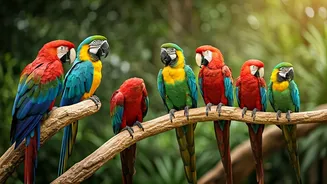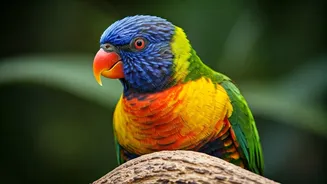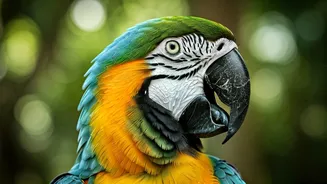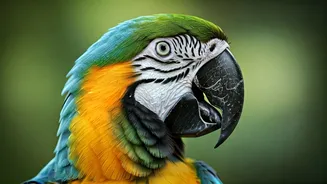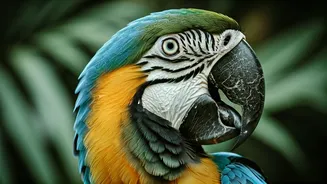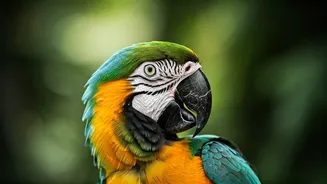Recognizing Familiar Voices
Parrots have a remarkable ability to identify voices, exhibiting auditory prowess. These avian companions can distinguish between voices, even after considerable
time has passed, showcasing the robust memory capabilities of the parrots. They achieve this recognition by focusing on unique vocal traits such as pitch, tone, and accent, which they then use to recall individuals they have encountered. The sensitivity they possess is so pronounced that they can discern subtle differences that can often be overlooked by humans. This talent is not just limited to human voices; parrots can also recognize familiar sounds and the voices of other animals they've interacted with. This recognition skill showcases their extraordinary cognitive abilities and their sophisticated methods of interaction and interpretation in their environments. They build strong connections to auditory cues, demonstrating advanced cognitive ability.
Unique Personalities Unveiled
Each parrot is a unique individual with its distinct character. Just like humans, parrots display a wide array of temperaments, ranging from playful and extroverted to shy and introspective. Their personalities are molded by a combination of genetics, early-life experiences, and the environment in which they are raised. Some parrots are naturally inclined to be social butterflies, craving interaction and attention. Others may be more reserved, preferring their own company or a select few companions. The way parrots express their individuality is also incredibly diverse. Some may show off through their vibrant plumage, others through their vocalizations, and some through their specific preferences for toys, activities, and interactions. Understanding the distinct personality of a parrot is key to fostering a positive and enriching relationship. This also makes the parrot's well-being and happiness a priority.
Communication Beyond Words
Parrots communicate far beyond vocalizations; they use body language to express a spectrum of emotions and intentions. By observing the subtle cues of feather posture, head position, and eye movements, one can gain insight into a parrot's state of mind. For example, a relaxed parrot might have slightly puffed-up feathers and a calm demeanor, while an agitated parrot might exhibit tightly held feathers and dilated pupils. Tail movements also play a critical role in parrot communication, which can signal excitement, fear, or a desire for attention. The ability to interpret these non-verbal cues is essential for understanding a parrot's needs and fostering effective communication, forming a bond with a parrot. By paying attention to these cues, humans can better understand and respond to their parrots' emotional and physical states, ensuring their comfort and well-being. This non-verbal communication is vital for establishing trust and strengthening the bond between parrots and their human companions.
Signs of Emotion Revealed
Parrots exhibit a broad range of emotions, and their behavior reveals their feelings. They express joy through playful antics, such as dancing, hopping, and vocalizations. When content, they may exhibit relaxed postures, engage in self-grooming, and make soft, pleasant sounds. Signs of fear or anxiety can be displayed through a rigid posture, flattened feathers, and rapid breathing. Frustration or anger may manifest as aggressive behavior, such as biting or lunging. Sadness or depression can result in a withdrawn demeanor, a loss of appetite, and a disinterest in their surroundings. Recognizing these emotional signals is crucial for providing proper care and support. Understanding their emotions allows you to respond appropriately, ensuring their mental and emotional well-being. By observing and understanding the signs, you can adjust your interactions and create an environment that promotes happiness and a sense of security.
Strong Social Connections
Parrots thrive on social interaction and form strong bonds, crucial for their emotional well-being. They establish social structures, often within flocks, where they interact, share resources, and provide mutual support. This social interaction provides them with a sense of security and belonging, reducing stress and promoting overall health. Parrots also form attachments with their human companions, recognizing them as members of their social group. These relationships are often characterized by mutual affection, trust, and a desire for interaction. Positive social connections contribute significantly to a parrot's happiness, and lack of social interaction can lead to loneliness, anxiety, and behavioral issues. Providing opportunities for social interaction, whether with other parrots or humans, is key to keeping parrots engaged and fulfilled. These strong social connections help enrich their lives.
Sharp Minds at Work
Parrots are known for their remarkable intelligence and cognitive abilities. They display problem-solving skills, learning through observation, trial and error, and even the ability to use tools. They can learn to mimic human speech, understand complex commands, and recognize objects and patterns. Their intelligence extends beyond simple mimicry, as they also use language to communicate needs and desires. Research indicates that certain parrot species have cognitive abilities comparable to those of young children. Their capacity for learning and adaptation makes them highly responsive to training and enrichment activities. Stimulating their minds with puzzles, interactive toys, and training sessions is vital for keeping them engaged and preventing boredom. Regular mental stimulation helps keep their minds sharp and encourages a healthy lifestyle, promoting their intellectual growth.
Communication Through Actions
Parrots use their actions and behaviours as a crucial mode of communication, showing their true feelings and intentions. They can express a variety of emotions through their behavior. A parrot that is in a happy and comfortable mood might engage in activities like preening, playing, and vocalizing in a cheerful manner. Conversely, a parrot feeling anxious or stressed could display behaviors like feather plucking or pacing. Aggression might manifest through biting or lunging. The way a parrot interacts with its surroundings—whether it's exploring, avoiding, or interacting with objects—can provide insights into its inner state. These behaviors serve as the parrots' way of expressing their thoughts, needs, and desires. Understanding this language of actions enables one to interpret their intentions, respond appropriately, and maintain a harmonious relationship with these birds.
Recognizing Familiar Faces
Parrots have the ability to differentiate between individuals, utilizing visual cues to identify the faces of those around them. They possess a keen sense of observation, remembering the unique features of the faces they encounter. Through visual recognition, they can distinguish between their human companions and unfamiliar individuals. This ability to identify faces enables them to differentiate between familiar and unfamiliar people, which helps in establishing bonds and determining social interactions. This recognition skill also plays a vital role in their social dynamics, whether they are living within a flock or interacting with their human counterparts. Their capacity to recognize faces suggests that they have developed a strong level of cognitive skill and can establish meaningful relationships with those around them, demonstrating their sophisticated understanding of their social environments.


